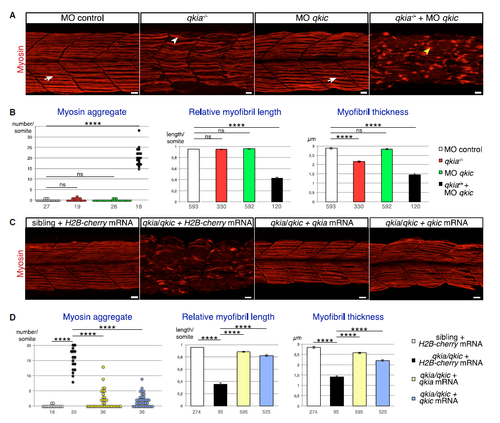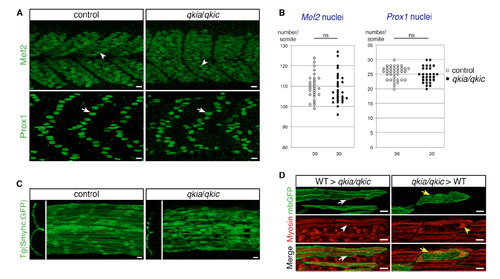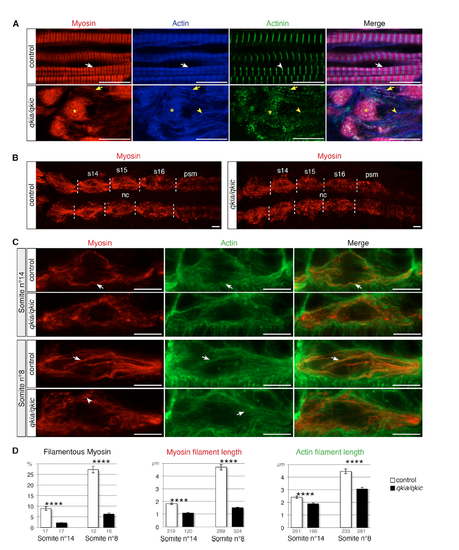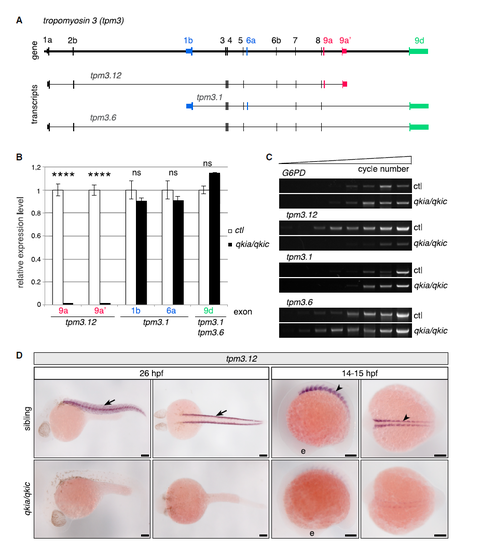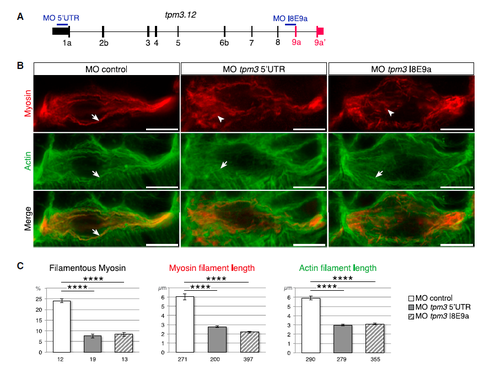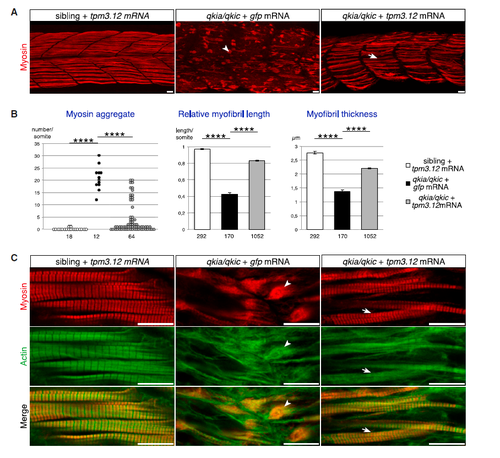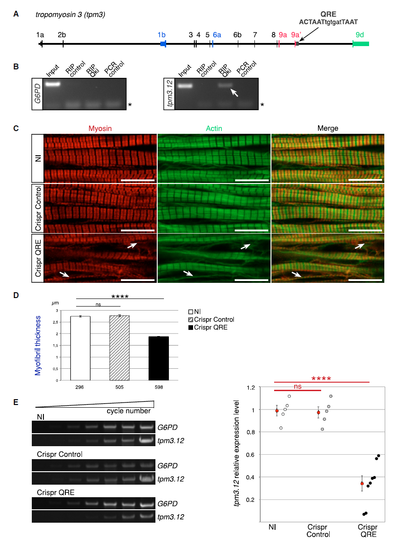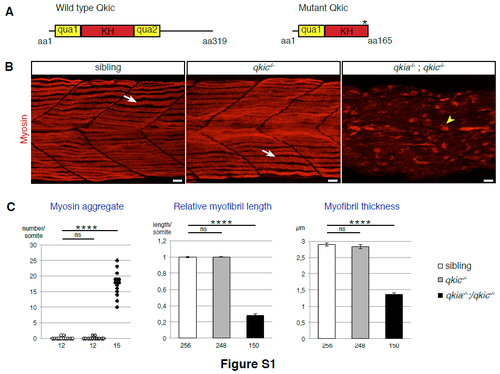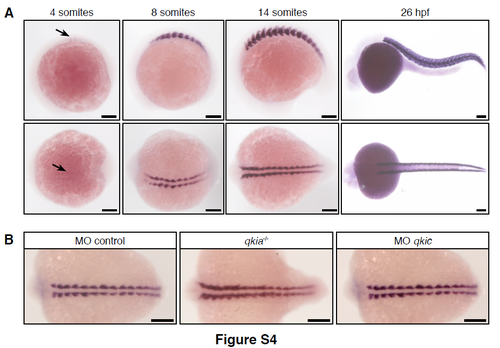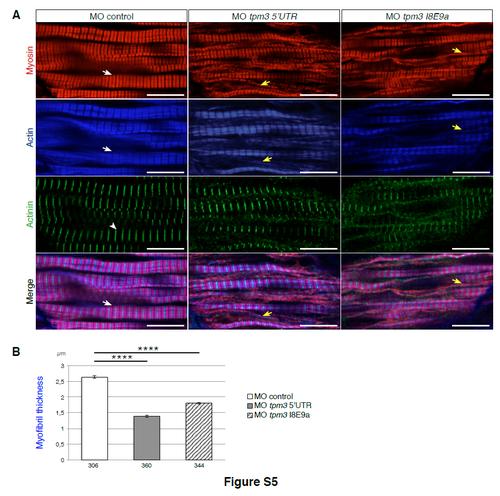- Title
-
Quaking RNA-Binding Proteins Control Early Myofibril Formation by Modulating Tropomyosin
- Authors
- Bonnet, A., Lambert, G., Ernest, S., Dutrieux, F.X., Coulpier, F., Lemoine, S., Lobbardi, R., Rosa, F.M.
- Source
- Full text @ Dev. Cell
|
qkia and qkic Functionally Interact to Control Muscle Formation in Slow Muscle Cells (A) qkia and qkic are required for slow muscle formation. Confocal imaging with z projection of myosin-immunostained 26-hpf zebrafish embryos from intercrosses of qkia+/− parents (lateral view). WT or qkia+/− embryos injected with either control MO (left panel, n = 42) or qkic MO (middle right panel, n = 125) exhibit WT myofibrils (arrow). qkia−/− embryos injected with control MO (middle left panel, n = 21) develop moderate myofibril defects (white arrowhead) whereas injection of qkic MO into qkia−/− embryos (right panel, n = 55) leads to a severe disruption of myofibrils (yellow arrowhead). (B) Quantification of the myofibril phenotype illustrated in (A). qkia−/− (n = 5), but not qkic morphant embryos (n = 8) display significantly thinner myofibrils compared with control morphant embryos (n = 9) (Student's t test, p = 2 × 10−30 and 0.6, respectively). qkia−/− embryos injected with qkic MO (n = 6) have significantly more myosin aggregate per somite (Student's t test, p = 1.9 × 10−13), as well as shorter and thinner myofibrils compared with embryos injected with control MO (Student's t test, p = 9 × 10−53 and 1.8 × 10−74, respectively). Numbers under the graph indicate the total number of quantified somites (left graph) and myofibrils (right and middle graphs). ns, not significant. (C) Either qkia or qkic can rescue qkia/qkic myofibril defects. Confocal imaging with z projection of myosin-immunostained 26-hpf zebrafish embryos from intercrosses of qkia+/−;qkic−/− parents (lateral view). qkia−/−;qkic−/− embryos injected with either qkia (n = 10) or qkic (n = 11) mRNA do not develop the severe myofibril defects observed in qkia−/−;qkic−/− embryos injected with H2B-cherry mRNA (n = 12), but rather form myofibrils similar to control (sibling embryos injected with H2B-cherry mRNA, n = 36). (D) Quantification of the myofibril phenotype illustrated in (C). qkia−/−;qkic−/− embryos injected with either qkia (n = 10) or qkic (n = 11) mRNA have significantly fewer myosin aggregate per somite, as well as longer and thicker myofibrils compared with qkia−/−;qkic−/− embryos injected with H2B-cherry mRNA (n = 4) (Student's t test, p < 1 × 10−10 and p < 1 × 10−30, respectively). Numbers under the graph indicate the total number of quantified somites (left graph) and myofibrils (right and middle graphs). In all panels, anterior is to the left. Pooled data are presented as mean ± SEM. ∗∗∗∗p < 1 × 10−4. Scale bars, 10 μm. See also Figure S1. |
|
qkia and qkic Control Cells Autonomously Slow Muscle Cell Differentiation (A) Slow muscle cells in embryos with impaired qkia and qkic function are specified. Confocal imaging with z projection of Mef2 and Prox1-immmunostained 26-hpf zebrafish embryos (lateral view). Mef2 is expressed similarly in slow (arrowheads) and fast muscle cells of control (sibling from intercrosses of qkia+/−;qkic+/− parents, n = 10) and qkia−/−;qkic−/− embryos (n = 10). Slow muscle cells also express Prox1 (arrows) similarly in control (WT or qkia+/− embryos injected with control MO, n = 32) and qkia−/− embryos injected with qkic MO (n = 24). (B) Quantification of Mef2 and Prox1 positive nuclei illustrated in (A). The number of Mef2-positive cells in control (sibling from intercrosses of qkia+/−;qkic+/− parents, n = 10 embryos) and qkia−/−;qkic−/− embryos (n = 10 embryos) is similar (Student's t test, p = 0.49). qkia−/− embryos injected with qkic MO also have a similar number of Prox1-positive cells (n = 12 embryos) as qkic MO-injected qkia−/− embryos (n = 10 embryos) (Student's t test, p = 0.32). Numbers under the graph indicate the total number of quantified somites. ns, not significant. (C) Slow muscle cells in embryos with impaired qkia and qkic function are correctly located within the somite. Confocal imaging of 26-hpf tg(Smyhc:GFP) zebrafish embryos (endogenous fluorescence) in reconstructed transverse view (left panel) or lateral view with z projection (right panel). Slow muscle cell migration toward the somite surface is not affected in qkia−/− embryos injected with qkic MO (n = 48) compared with control (sibling embryos injected with control MO, n = 54). (D) qkia and qkic control slow muscle myofibril formation cell autonomously. Transplantation of WT mbGFP-expressing slow muscle precursors into a qkia/qkic embryo (left panel) and qkia/qkic slow muscle precursors into a WT embryo (right panel). See STAR Methods for details. Confocal imaging with z projection of GFP (green) and myosin (red) immunostained 26-hpf zebrafish embryos (lateral view). WT slow muscle cells (white arrows) develop normal myofibrils (white arrowhead) in qkia/qkic embryos (n = 28 cells) whereas qkia/qkic cells (yellow arrows) form myosin aggregates (yellow arrowhead) in WT embryos (n = 19 cells). In all panels, anterior is to the left. Scale bars, 10 μm. |
|
qkia and qkic Control Nascent Myofibril Formation through Myosin Filament Assembly (A) qkia and qkic control sarcomere formation. Confocal imaging of myosin (red), actin (blue), and actinin (green) immunostaining at 26 hpf (lateral view from single optical sections). Slow muscle myofibrils in control embryos (WT or qkia+/− embryos injected with control MO) (n = 46) display the typical actin and myosin striated pattern (white arrows) with sharp bands of actinin (white arrowhead). Slow muscle cells in qkia/qkic embryos (qkia−/− embryos injected with qkic MO) (n = 33) contain myosin/actin aggregates (asterisks) decorated with actinin dots, myosin/actin filaments also decorated with actinin dots (yellow arrows), and actin filaments devoid of myosin (yellow arrowheads). (B and C) qkia and qkic control myosin filament assembly in early differentiating slow muscle cells. Confocal imaging of myosin (red) and actin (green) immunostaining at 17 hpf (16-somite stage) in control (WT or qkia+/− embryos injected with control MO) and qkia/qkic embryos (qkia−/− embryos injected with qkic MO), dorsal view. (B) View of all slow muscle cells in posterior somites (z projection). Somites 14 to 16 (s14–s16) borders are indicated by dashed lines. nc, notochord; psm, pre-somitic mesoderm. (C) Focus on one slow muscle cell (single optical section). In control embryos (n = 10), myosin and actin gradually organize into long filamentous structures (arrows), prefiguring slow muscle differentiated myofibrils. In qkia/qkic embryos (n = 13), actin retains the capacity to form filamentous structures (arrows) while myosin instead forms short stretches (arrowhead) or remains diffuse. (D) Quantification of the myofibril phenotype illustrated in (C). At 14th somite level, in qkia/qkic embryos (n = 5), myosin and actin filaments are significantly shorter (Student's t test, p = 4 × 10−17 and 3 × 10−6, respectively) and myosin is less condensed into filaments (Student's t test, p = 5 × 10−8) compared with control embryos (n = 5). In more differentiated cell (eighth somite level), in qkia/qkic embryos (n = 4) myosin and actin filaments are still significantly shorter (Student's t test, p = 6 × 10−40 and 4 × 10−10, respectively) and myosin is less condensed (Student's t test, p = 1 × 10−8) compared with control embryos (n = 4). Numbers under the graph indicate the total number of quantified sections (left graph) and myosin and actin filaments (middle and right graph). Data are presented as mean ± SEM. In all panels, anterior is to the left. ∗∗∗∗p < 1 × 10−4. Scale bars, 10 μm. EXPRESSION / LABELING:
PHENOTYPE:
|
|
qkia and qkic Control tpm3.12 Transcript Level in Slow Muscle Cells (A) Schematic of the tropomyosin 3 gene and transcripts. Transcripts and exons are named according the nomenclature recommended in Geeves et al. (2015). tpm3.12- and tpm3.1-specific exons are indicated in red and blue, respectively, and the common exon between tpm3.1 and tpm3.6 transcripts is in green. (B) The expression of tpm3.12-specific exons is dramatically reduced in qkia/qkic embryos at 24–26 hpf, while the expression of tpm3.1- and tpm3.6-specific exons is not affected. Relative expression level of tpm3 transcripts in control (WT or qkia+/− embryos injected with control MO) versus qkia/qkic embryos (qkia−/− embryos injected with qkic MO) using exon-mapped reads from RNA sequencing. Expression in control embryos is set at 1 for each transcript. Data are presented as mean ± SEM; n = 3, p < 1 × 10−150 (see STAR Methods for details). ns, not significant. (C) qkia and qkic are specifically required to control tpm3.12 transcript level at 24–26 hpf. The expression of the three tpm3 transcripts was assessed using semi-quantitative RT-PCR in control (WT or qkia+/− embryos injected with control MO) versus qkia/qkic embryos (qkia−/− embryos injected with qkic MO) (n = 3). G6PD is used as a control gene. For each transcript, PCR products from both conditions were taken from successive PCR cycles and resolved by electrophoresis. (D) qkia and qkic control tpm3.12 expression in slow muscles from early somitogenesis. In situ hybridization on the offspring from the intercross of qkia+/−;qkic−/− carriers. In control siblings, tpm3.12 is expressed in trunk muscles (arrows) at 26 hpf (n = 67/90) and in slow muscle precursors (arrowheads) at 14/15 hpf (10/12-somite stage) (n = 37/50). In qkia−/−;qkic−/− embryos, tpm3.12 expression is downregulated at both 26 hpf (n = 23/90) and 14/15 hpf (n = 13/50). Lateral (left panel) and dorsal views (right panel) of the same embryo are shown. e, eye. In all panels, anterior is to the left. ∗∗∗∗p < 1 × 10−4. Scale bars, 100 μm. See also Figures S2–S4. EXPRESSION / LABELING:
PHENOTYPE:
|
|
Tropomyosin-3 Is Required for the Early Steps of Myofibril Formation (A) Schematic of the tpm3.12 transcript indicating the position of the two different MO. Exon numbers are indicated below the transcript. (B) Confocal imaging of myosin (red) and actin (green) immunostained embryos at 16 hpf (15-somite stage) (dorsal view from single optical section). WT embryos were injected with control MO or tpm3 MO targeting either the 5′ UTR or the junction between intron 8 and exon 9a (I8E9a junction). In control embryos (n = 31), in somite 7, myosin and actin organize into long filamentous structures (arrows). In both types of tpm3 morphant embryos (5′ UTR MO, n = 14; I8E9a MO, n = 40), actin forms thin filamentous structures (arrows) whereas myosin localizes in short stretches (arrowheads) or remains diffuse. In all panels, anterior is to the left. Scale bars, 10 μm. (C) Quantification of the myofibril phenotype illustrated in (B). In both types of tpm3 morphant embryos (5′ UTR MO, n = 8; I8E9a MO, n = 4), myosin and actin filaments are significantly shorter (Student's t test, 5′ UTR MO: p = 3 × 10−20 and 3 × 10−27, respectively; I8E9a MO: p = 3 × 10−25 and 6 × 10−27, respectively) and myosin is less condensed into filaments (Student's t test, 5′ UTR MO: p = 1 × 10−6; I8E9a MO: p = 1 × 10−11) compared with control embryos (n = 4). Numbers under the graph indicate the total number of quantified sections (left graph) and myosin and actin filaments (middle and right graph). Data are presented as mean ± SEM. ∗∗∗∗p < 1 × 10−4. See also Figure S5. EXPRESSION / LABELING:
PHENOTYPE:
|
|
Tpm3.12 Restores Myofibril Formation in qkia/qkic Embryos Embryos from intercrosses of qkia+/− parents were injected with qkic MO in combination with GFP or tpm3.12 mRNA. (A) Confocal imaging of myosin-immunostained 26-hpf zebrafish embryos (lateral view with z projection). In qkia/qkic embryos overexpressing GFP (n = 11), strong myofibril defects such as myosin aggregates (arrowhead) are observed. Injection of tmp3.1 mRNA in sibling embryos (n = 99) does not affect myofibril development whereas in qkia/qkic embryos (n = 33), it rescues the formation of myofibrils in most muscle cells (arrow). (B) Quantification of the myofibril phenotype illustrated in (A). All qkia/qkic embryos injected with tpm3.12 mRNA somite (n = 21) have significantly less myosin aggregate per somite (Student's t test, p = 3.5 × 10−9), as well as longer and thicker myofibrils (Student's t test, p = 2.7 × 10−27 and 2.2 × 10−7, respectively) compared with qkia/qkic embryos injected with GFP mRNA (n = 4), albeit less long and thick than myofibrils of sibling embryos injected with GFP mRNA (n = 4). Numbers under the graph indicate the total number of quantified somites (left graph) and myofibrils (right and middle graphs). Pooled data are presented as mean ± SEM. ns, not significant. (C) Confocal imaging of myosin (red) and actin (green) immunostained 26-hpf zebrafish embryos (single optical section). In qkia/qkic embryos overexpressing GFP, numerous myosin and actin aggregates (arrowheads) are observed. Injection of tmp3.1 mRNA into sibling embryos does not affect myofibril development whereas in qkia/qkic embryos, it rescues the formation of myofibrils, which display the typical striated pattern of actin and myosin (arrows). In all panels, anterior is to the left. ∗∗∗∗p < 1 × 10−4. Scale bars, 10 μm. |
|
The Quaking-Binding Site Located in the 3′ UTR of tpm3.12 Transcript Is Required for Myofibril Formation and Accumulation of tpm3.12 Transcripts (A) Schematic of the tpm3 gene indicating the position and sequence of the Qki-binding site in exons (QRE, bold). Exon numbers are indicated above the transcript. Specific exons are colored as in Figure 4. (B) Qki proteins physically interact with tpm3.12 mRNA in 17-hpf zebrafish embryos. tpm3.12 mRNA was detected following RNA immunoprecipitation with Qki antibody (arrow), but not with control antibody. G6PD is used as a control mRNA. Position of PCR primers is indicated by asterisks. (C) Mutations in the QRE located in the 3′ UTR of tpm3.12 transcript lead to myofibril defects at 26 hpf. Confocal imaging of myosin (red) and actin (green) immunostained 26-hpf zebrafish embryos (lateral view from single optical sections). Injection of CRISPR Control RNA (n = 8) into zebrafish embryos does not affect myofibril formation compared with non-injected (NI) embryos (n = 8), whereas injection of CRISPR RNA targeting tpm3.12 QRE (n = 15) leads to myofibrils with splitting defects (arrows). In all panels, anterior is to the left. Scale bars, 10 μm. (D) Quantification of the myofibril phenotype illustrated in (B). NI embryos (n = 4) and embryos injected with CRISPR control (n = 6) display myofibrils of similar thickness (Student's t test, p = 0.5), whereas embryos injected with CRISPR QRE (n = 6) have significantly thinner myofibrils (Student's t test, p = 2 × 10−55). Numbers under the graph indicate the total number of quantified myofibrils. (E) tpm3.12 transcript level is reduced in embryos with mutated QRE at 26 hpf. tpm3.12 expression was assessed using semi-quantitative RT-PCR in single embryo (NI, injected with CRISPR control RNA or CRISPR RNA targeting tpm3.12 QRE). For each single embryo, PCR products were taken from successive PCR cycles and resolved by electrophoresis (left panel). tpm3.12 expression level was quantified and normalized to G6PD (right panel). Each dot represents a single embryo. For each condition, the mean of single embryos is indicated by a red dot, on the left of the dot group. Student's t test, p = 8.77 × 10−6. Pooled data are presented as mean ± SEM. ∗∗∗∗p < 1 × 10−4. ns, not significant. See also Figure S6. |
|
Related to Figure 1. Myofibril formation is severely affected in qkia/qkic double mutant embryos. (A) Generation of the qkic mutant allele. Wild-type Qkic protein consists of 319 amino acids (aa) and contains a KH domain flanked by two qua domains, which mediate RNA binding and dimerisation. The qkic mutant allele (qkic463_464insTCAC) generated by the zinc finger technology contains four nucleotides inserted within exon 4. This insertion generates a premature stop codon within the KH RNA binding domain, which is predicted to result in a truncated protein (165aa long) devoid of RNA binding capacity. (B) Myofibril formation is severely affected in qkia/qkic double mutant embryos, but not in qkic mutant embryos. Confocal imaging with z-projection of myosin-immunostained 26 hpf zebrafish embryos from intercrosses of qkia+/-;qkic+/- parents (lateral view). Similarly to WT, single and double qkia/qkic heterozygous embryos (sibling, n=16), qkic mutant embryos (n=20) exhibit wild-type myofibrils (arrow). In contrast, qkia/qkic double mutant embryos (n=17) display severely affected myofibrils with myosin aggregates (arrowhead). Anterior is to the left. Scale bar 10μm. (C) Quantification of the myofibril phenotype illustrated in B. Myofibrils of sibling and qkic-/- embryos are similar (Student’s t-test, P>0.3). In contrast, qkia-/- ; qkic-/- embryos have significantly more myosin aggregate per somite (Student’s t-test, P=5.7x10-11), as well as shorter and thinner myofibrils compared to sibling embryos (Student’s t-test, P=1.6x10-107 and 5.5x10-82 respectively). For each condition, 4 embryos were analysed. Numbers under the graph indicate the total number of quantified somites (left graph) and myofibrils (right and middle graphs). Pooled data are represented as mean +/- SEM. |
|
Related to Figure 4. qkia and qkic are not individually essential for tpm3.12 expression in differentiating slow muscle cells. (A) tpm3.12 is expressed in differentiating slow muscle cells. tpm3.12 transcripts are first detected by in situ hybridization at 11 hpf (4-somite stage) in slow muscle cells (arrow). Its expression pattern in differentiating slow muscle cells follows the antero-posterior progression of somitogenesis until 26 hpf, when tpm3.12 transcripts are specifically expressed in trunk muscle. Note that embryos at 26 hpf are overstained to ensure that tpm3.12 is not expressed in other cells than muscle cells. Lateral (top panel) and dorsal views (bottom panel) of the same embryo are shown. (B) tpm3.12 expression is not affected in qkia mutant or qkic morphant embryos. At 14/15 hpf (10/12- somite stage), tpm3.12 expression is similar in sibling and qkia-/- embryos injected with control MO (n=23) as well as in sibling injected with qkic MO (n=40). In all panels, anterior is to the left. Scale bar 100μm. |
|
Related to Figure 5. Tropomyosin 3 loss of function leads to moderate myofibril defects at 26 hpf. (A) Confocal imaging of myosin (red), actin (blue) and actinin (green) immunostaining in 26 hpf WT embryos injected with control MO or tpm3 MO targeting either the 5'UTR or the exon/intron junction I8E9a (lateral view from single optical section). Slow muscle myofibrils in control morphant embryos (n=39) display the typical actin and myosin striated pattern (white arrow) with sharp bands of actinin (white arrowhead). Striated myofibrils are also present in both types of tpm3 morphant embryos (MO 5'UTR, n= 34) and MO I8E9a (n=42), but they display splitting defects (yellow arrow). In all panels, anterior is to the left. Scale bar 10μm. (B) Quantification of the myofibril phenotype illustrated in A. In both type of tpm3 morphant embryos, myofibrils are thinner compared to WT embryos injected with control MO (Student’s t-test, P=2x10-73 and 8.5x10-37 respectively). For each condition, 4 embryos were analysed. Numbers under the graph indicate the total number of quantified myofibrils. Data are represented as mean +/- SEM. |
Reprinted from Developmental Cell, 42(5), Bonnet, A., Lambert, G., Ernest, S., Dutrieux, F.X., Coulpier, F., Lemoine, S., Lobbardi, R., Rosa, F.M., Quaking RNA-Binding Proteins Control Early Myofibril Formation by Modulating Tropomyosin, 527-541.e4, Copyright (2017) with permission from Elsevier. Full text @ Dev. Cell

